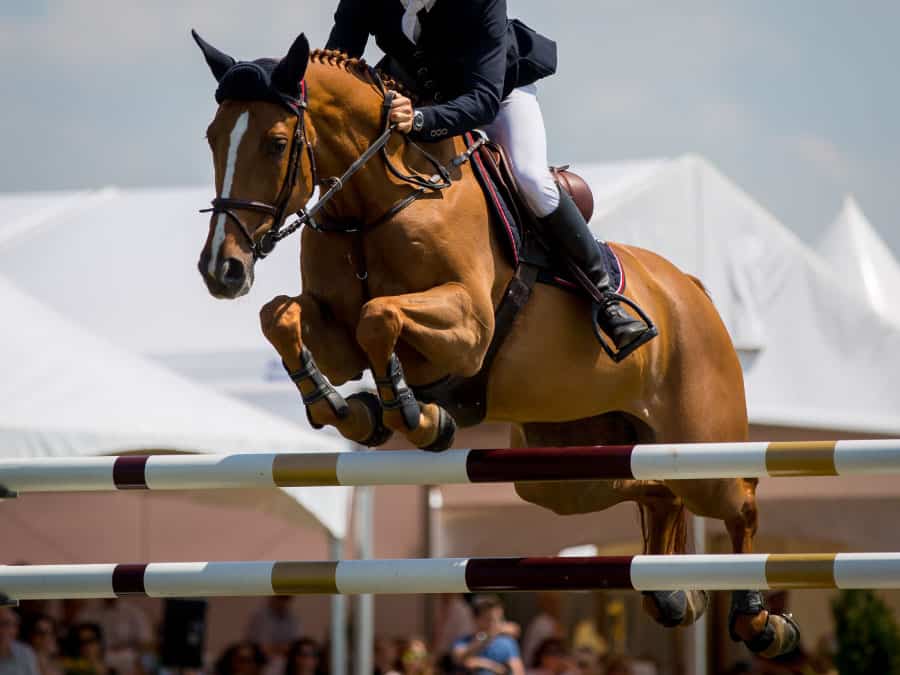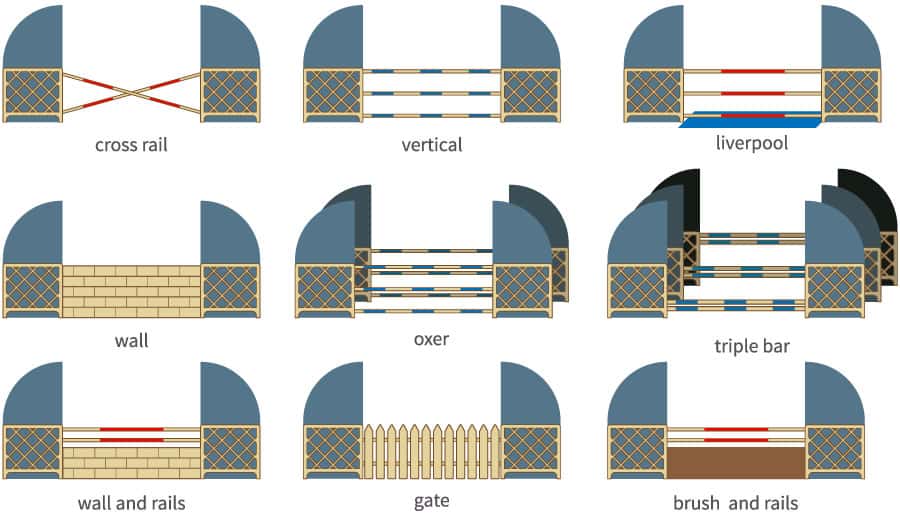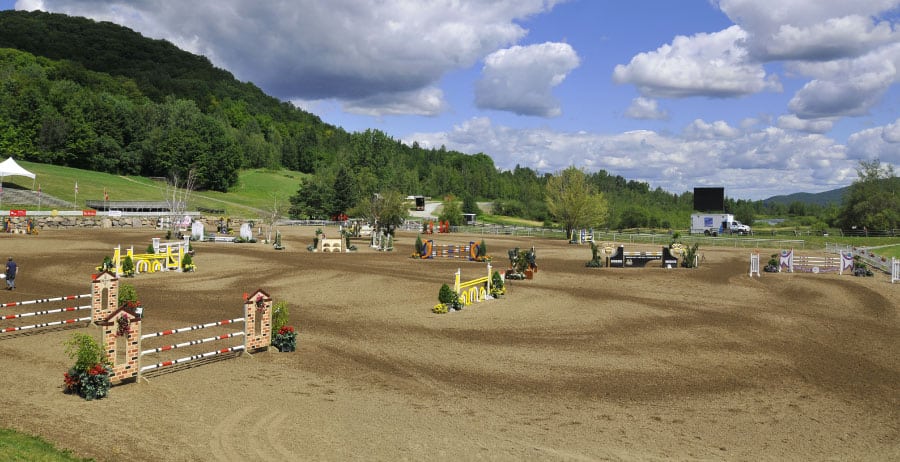- Your source for stall mats, rubber arena footing, arena harrows and arena dust control.

Showjumping is more complicated than it looks. There are many contributing factors to the design of a show jumping course. The type of show jumping class, the height of the jumps, and the technicality of the jumps play a huge role in the number of jumps in a showjumping course.
The average show jumping track contains 10 to 12 jumping obstacles per round that is usually followed by a shortened course of 6 jumps over time. The number of jumps will depend on the class, the heights of the jumps, and levels that are being ridden at a competition.
Though it sounds complicated, lets break it down and get into more detail.
The different kinds of jumps in Showjumping
Let’s start off by looking at the different types of jumps there are in showjumping.
Basic jumps
Cross rails
Just as it sounds, a cross jump is made up of two poles crossing each other in the middle. Each pole is placed on a cup on one side, each whilst the other side stays on the ground. The cross is the most basic and widely used jump as it is quite easy to adjust the height, and it looks less intimidating to beginner jumpers.
Uprights / Verticals
Uprights or vertical jumps consist of two or more poles stacked vertically on top of each other. This is not a very technical jump as it has no width to it and is a basic in every show jumping course.
Oxers
Oxers are best described as two vertical jumps placed at a reasonable width apart to create a wider jump. Oxers can come in many different shapes and forms, and the width increases as the heights go up, thus making for a much more technical jump.
Here are some types of oxers commonly seen in the competition ring:
- Box Oxer – The box oxer or square oxer has both vertical poles at the same height, and the width of the jump is equal to its height.
- Ascending oxer – The back pole (the one furthest from the take-off point) is set higher than the front pole. This gives the jump a more intimidating effect because it seems much bigger than it is.
- Descending oxer – The back pole (the one furthest from the take-off point) is set lower than the front pole. This adds more technicality to the jump as the rider needs to prepare the horse for the lower back pole that adds width to the jump but is not necessarily easily seen by the horse.
- Swedish oxer – This oxer is built in an “X” shape, much like the cross jump but added width. The front pole (one closest to the take-off point) is lifted on only one side, and the back pole (one furthest from the take-off point) will be lifted on the opposite side than the front.
- Tiple Bar – A variation of the oxer, the triple bar, is an oxer with an extra pole. This might be one of the most challenging show jumps as this adds even more “bulk” to the jump, making it seem bigger and wider.
- Hogs back – The hogs back is a variation of the triple bar, but the poles are set at different heights. The middle pole will be the highest, the front and the back pole will be lower than the middle pole.
The more flamboyant jumps
Walls
Wall jumps provide a more technical aspect to the jumping course as it is built to look like a solid, big stone or brick wall. This challenges the horse and rider’s bravery. The blocks that the wall jump is made of is lightweight, and it falls apart easily as to not injure the horse or rider.
Water jumps
The water jump challenges the horse and rider to jump a wide jump rather than high. The water jump is a rectangular shape that is dug into the ground – although not very deep – and filled with water. Should the horse touch the side of the water, it results in a penalty.
Liverpool
Liverpools are similar to water jumps, but it includes poles that add height to the jump. The horse needs to clear the water and the poles over the water. Liverpools are not as wide as normal water jumps.
Fans
The poles of the fan jump are placed on top of each other on one upright on the one end, and on the other, the poles will be spread out to form the shape of a fan and be placed on their own upright.
Other jumps
Combinations
A combination jump includes two or more obstacles (separate jumps) that are placed close together, 1 to 2 strides – to test the control of the horse and rider. The combination of jumps counts as one single jump but will be numbered using alphabet letters. E.g., 10A and 10B. This means that there are two obstacles for the horse to jump, but it counts as one combined jump.
Related distances
These differ from combinations as the jumps or obstacles are placed further away and numbered separately. A related distance has 3 or more strides in between and is usually set in a straight line from each other.

The different classes in Show Jumping
Although there are many more classes with their own set of rules, these are the most common classes seen in show jumping:
Competition
A normal competition course consists of up to 12 jumps that need to be jumped clear in the first round. This means that the rider and horse combination must not receive any penalties in the first round. After that, there will be a jump-off. The jump-off is done over a shortened course in the initial course and against the clock.
Two-phase competition
Two-phase courses are two courses within one arena, which is jumped immediately after the other. Course 1 comprises 7 to 9 obstacles – with or without combinations – the finish line is then also the start line for the second course, which then consists of 4 to 6 obstacles, which can contain one combination.
The rider may only continue jumping the second course if they had a clear round in the first course. Should they receive penalties in the first course, the rider will be stopped after the finish line of the first course.
Both courses can be run against the clock or not. Each course can also be done at different speeds/times.
Accumulator
The accumulator course has either 6, 8, or 10 obstacles, and each obstacle is more difficult than the previous one. The difficulty can be increased through height, width, and technicality. When the horse clears the obstacle, they are awarded points.
Jump 1 gives one point; jump 2 gives 2 points, and so on. Should the pole be knocked off, there are no points rewarded. The last obstacle of the course will have an alternative obstacle called the Joker; this will be the most difficult obstacle in the course and carries a double point value.
But should there be a knock on the Joker, the total points of the Joker are then deducted from the total points that the rider accumulated. The competition can be held against the clock, not against the clock and with or without a jump-off.
Grand Prix
There is one GP show per year at a selected venue. The rider and horse combinations will jump two courses. The first course will have 10 to 12 jumps; this will include one double combination (2 jumps) and one triple combination (3 jumps) as well as a water jump should the venue be able to provide one.
The riders that retire or are eliminated from the first round will not continue to jump the second round on the second course. The second course consists of 8 jumps, including one double combination.
The rider with the least amount of penalties in both courses, as well as the fastest time in the second course, will be the winner. If there is a tie, the riders will do a jump-off on a shorter course based off of the first course. The fastest round wins.
Derby
The Derby is also held once a year. The rider-horse combinations need to complete at least one of the three qualifying rounds to compete in the Derby.
Qualifying round 1: Two-phase competition
Qualifying round 2: Normal Competition with one jump off
Qualifying round 3: A2 Competition
The Derby course consists of up to 16 obstacles, with a total of about 23 jumps. The course is anywhere from 1000m to 1300m long and the riders only have 180s to complete the course.
The course consists of natural-looking jumps such as water jumps, ditches, jumps on top of and at the bottom of an embankment, gates, and many more.

The height of jumps in Showjumping
Non-affiliated/non-graded heights can be anything from poles on the ground up to 80cm. After that, the riders are graded and need qualifying rounds to move up into the next height. These heights go from 1m up to 1.50m.
To move from 90cm to 1m classes, for example, the rider-horse combination needs to have 5 qualifying rounds in 90cm. This has to be a clear round (zero penalties).
From 1m to 1.10m, the rider needs to complete 5 rounds again before going up and so on. The Qualifying rounds required for the open classes increase to 10 rounds per height category – 1.30m to 1.50m (Depending on your region and/or country)
Conclusion
As discussed, there are many contributing factors to the design of a show jumping course and the number of jumps in competitions. The type of show jumping class, the height of the jumps, and the technicality of the jumps play a huge role in the number of jumps in a showjumping course.
Now that we’ve covered everything in quite a bit of detail, you hopefully have a clearer understanding of the number and types of jumps that are associated with various show jumping competitions.
Feel free to check out our other posts on Showjumping here .
.

